- Read
about various artists and characteristics of Kishangarh School of Painting not
to miss Bani Thani. Also know places of tourist interest in Kishangarh.
Kishangarh
painting, 18th-century school of the Rajasthani style of
Indian painting arose in the princely state of Kishangarh (central Rajasthan).
The
school is clearly distinguished by its individualistic facial type and
religious intensity. The sensitive, refined features of the men and women are
drawn with pointed noses and chins, deeply curved eyes, and serpentine locks of
hair. Their action is frequently shown to occur in large panoramic landscapes.
The
Mughal connection brought about interesting and important changes in Rajput
painting. These changes were visible in dress designs, architectural details,
art-Motifs, landscape patterns and choice of subject matter.
Painting
as an art form in Kishangarh is a very old tradition dating back nearly three
hundred and fifty years. This art in its heyday, with its influences deeply
steeped in Radha Krishna bhakti and the splendour of the natural beauty around
the environs of Kishangarh, had a unique ethereal almost mystical quality.
Though the school lasted for a shorter duration, it possessed much more refined style. The style of painting kindled religious intensity. The paintings depicted various events of epics and themes of gods and nature, such as from Sri Krishna’s life, the Mahabharata, the Ramayana, or the beautiful panoramic landscapes.

Reference
and credits
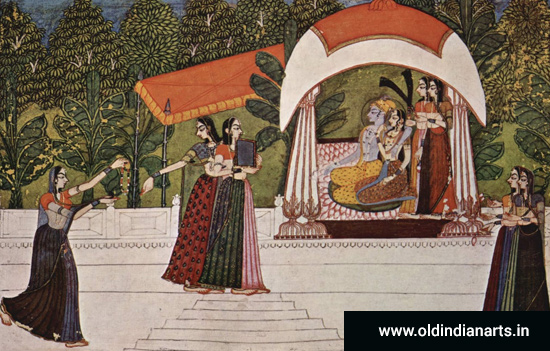
Reference
and credits
History of Kishangarh School of Paintings
The
school took shape and grew under the patronage of the king Savant Singh. He
ruled from 1748 and 1757. Later he left everything to become a hermit. It was
at this time that the Kishangarh art reached the zenith. He was also a poet,
and wrote under the name of Nagari Das. He was a pious man and followed
Vallabhacarya sect, which is known to worship Krishna, the divine lover.
He was inclined towards spirituality, aesthetics and religion. It was under his reign that the entire kingdom blossomed in devotional fervour and engaged in artistic production. Albeit at the end of the 17th century, many competent styles of paintings analogous to the late Mughal style of art were being undertaken. But it was Savant Singh who induced the inspiration for the series of paintings on the Radha-Krishna theme.
It is said that Savant Singh fell in love with a lady who was employed as a singer by his stepmother in her palace. The real name of the lady is obscure, but came to be known as Bani Thani (“Lady of Fashion”). There are speculations that the facial features in the Kishangarh paintings have been modelled on her features.
The
master artist who channeled the astounding works and artistic passions of his
patron into completely new visual outlook of images was Nihal Chand. The school
lasted till the 19th century and in 1820, a series of paintings that depicted
Gita Govinda were created.
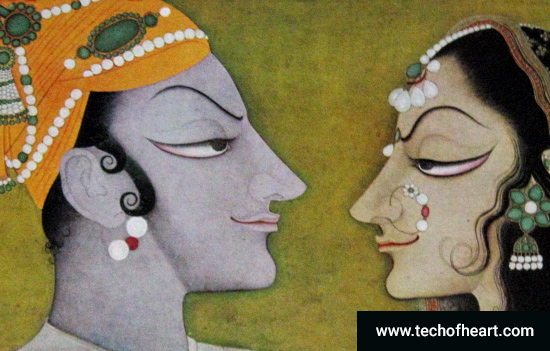
Reference
and credits
Bani Thani
Kishangarh School of paintings gave birth to a style of painting called Bani Thani. It is also popularly entitled as India’s Mona Lisa. It is a masterpiece creation by the great artist, Nihal Chand. It is being imprinted by the Indian Government on one of its postal stamps.
Bani Thani was a singer in the court of the king Savant Singh during the 18th century. Like him, she was also a poet. The king was enchanted by her beauty and exquisite elegance, and she soon became the king’s mistress. It is said that the king modelled as ‘Krishna’ and his mistress, Bani thani modelled as ‘Radha’, while Nihal Chand transformed their beauty in the form of a painting. Bani Thani turned out to be the legendary face of the “Kishangarh Radha”, an impeccable portrayal of the ideal beauty of Indian womanhood.
Prominent Artists
Girdhardas patronized by
Raja Raj Singh is the first known artist from Kishangarh. An inscription on the
portrait of Raj Singh bears his name.
Bhawanidas was well trained
in the Mughal style Indian paintings. He served under Raja Raj Singh and
produced paintings, which displayed luxurious courtly postures, delicately modelled
faces, and graceful figures that emphasized on the charm of the youthful
beauty.
Some of his notable works are; ‘A princess enjoying fire works’, ‘Queen listening to music’ and ‘Raja Sahasmal with his falconers’.
Dalchand and Kalyandas were related to Bhawanidas.
While Dalchand was the son of Bhawanidas, Kalyandas was a relative of Dalchand.
These artists established the Kishangarh School of painting, which flourished
immensely under Raja Raj Singh and later under Raja Sawant Singh. These artists
employed gold, a technique brought from Mughal workshops, in the paintings.
One of Dalchand’s significant works is the painting of a horse, which was presented to Mughal Emperor Farrukhsiyar.
While
Kalyandas is known for painting a portrait of Rao Durjan Sal of Kotah.
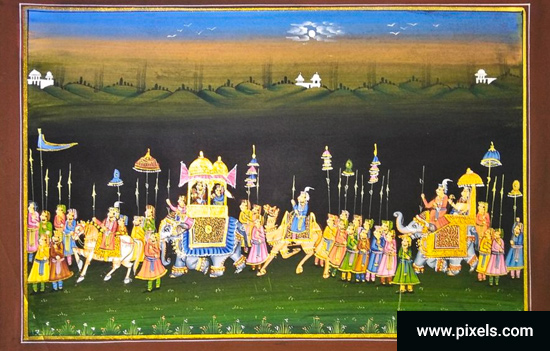
Reference
and Credits
Nooro Dhadi was a local
painter who painted Rathor Daulatsingh, a jagirdar of the State.
Nihal Chand
One
of the most outstanding painters was Nihal Chand (1710-1782) who produced
brilliant work. His name figures in the captions of paintings and the papers of
the Kishangarh State.
From
the period of 1755 to 1766 AD, Nihal Chand worked for Raja Sardar Singh who
ruled in the northern part of the partitioned State. He produced a memorable
work in the association of his team which consisted of Sitaram, Soorajmal, and
Amar
Chand.
After
the demise of Sardar Singh, Roopnagar was again merged with Kishangarh. Nihal
Chand returned to Kishangarh and was given 200 acres of land.
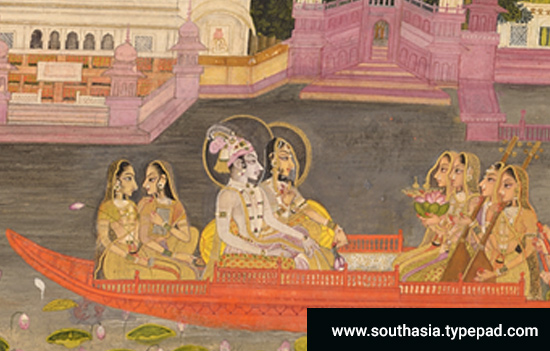
Reference
and Credits
Nihal Chand under Raja Sawant Singh, who was himself a poet and an accomplished musician and painter, rendered visual expression to Sawant Singh’s poems and feelings in his paintings. He was close to Sawant Singh and evolved a figure of Radha based on the appearance of Bani Thani, the mistress of Raja Sawant Singh. He evolved a mannerist style which emphasized on the slender curves and almond eyes of Bani Thani. Radha as Bani Thani was shown with delicate eyebrows curved like a bow, long neck, curls of ebony hair, shapely nose and fastidious nose.
The series of
Radha Krishna paintings depicting the mystical love between them are his
notable creations.
His painting called ‘Boat of Love’ is considered as a masterpiece of Kishangarh School of painting. The depiction of minutest details with sheer perfection celebrates the eternal love of Radha and Krishna. His other works include ‘Radha offering flowers to Krishna’, ‘Tambula Seva’, ‘Shukadeva Muni preaching Bhagavat to Parikshit’, ‘Sawant Singh and Bani Thani’ and ‘Radha and Krishna seated on a lotus’.
Nihal
Chand work speaks for its delicate and graceful drawing and distinctive
patterns, and colors.
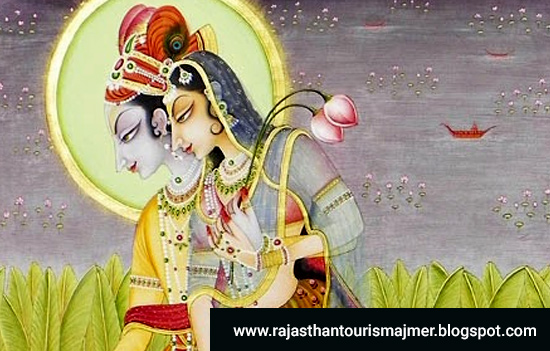
Reference
and Credits
The
painting style of Sitaram, eldest son of Nihal Chand closely resembles to that of his father. His notable works are ‘Krishna offering a garland to Radha’, ‘Krishna holding Radha’s Odhani’ and ‘Diwali festival’.
Sooraj Mal was brother of Sitaram
and his worthy sketches indicate his love for brush.
Soordhaj Nanagram was son of Sooraj
Mal and grandson of Nihal Chand. Painting of Kalyan Rai executed by him is his
noteworthy contribution.
Soordhaj Ramnath was son Nanagram.
He excelled in drawing and painting of flowers and fruits.
Amar Chand is remembered for his well-ordered compositions. His notable works include ‘A Moonlit Music Party’ that shows Raja Sardar Singh at his Roop Nagar Palace and also figures Nihal Chand.
Sooratram and Budhlal are other significant names,
which worked at Fatehgarh in the State and produced lovely works of art.
Kishangarh is also famous for its marbles.
Kishangarh can be explored in a day or two, and like any city
of Rajasthan, it has worthwhile experiences to offer.
Khoda Ganesh Ji Temple
A
unique temple of Lord Ganesha, Khoda Ganesh Ji is located 15 km from
Kishangarh. It was built by the royal family of Kishangarh about 250 years ago.
Perhaps,
the consecrated idol of Ganesh was unravelled from the ground, hence, it is
called Khoda Ganesh which translates into dugout Ganesh. In the present day,
this shrine is visited by all kinds of people, especially newly married couples
seeking the blessings of Lord Ganesh. Wednesdays are special days for offering
worship to Ganesh.
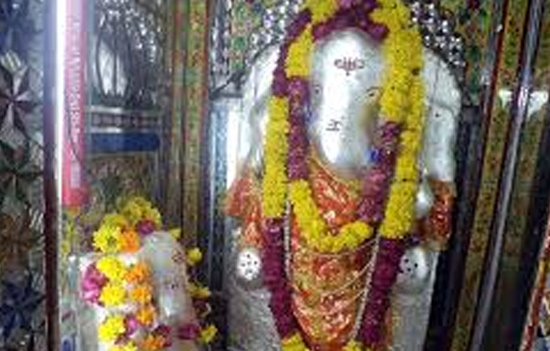 Khoda Ganeshji.
Khoda Ganeshji.
Kishangarh Fort
This fort located 19 km from Ajmer city was constructed at the command of Maharaja Roop Singh in 1649, hence called Roopangarh Fort.
One
of the remarkable features of this fort which makes it extraordinary is a deep
moated wall. Only permitted visitors and guests living in the adjacent Phool
Mahal Palace Hotel are allowed to enter this fort.
Phool Mahal Palace
Phool
Mahal Palace was made in 1870 as the royal monsoon retreat of the Maharaja of
Kishangarh. It lies at the centre of the city, and now serves as a boutique
hotel where guests are treated with the same warmth and honour as the royalty.
Reference
Ana Sagar Lake
Dating
back to the eighth century, this man-made lake is located 60 minutes from
Kishangarh. It was constructed by the grandfather of a local well-known
warrior. A Jain temple is also located near the lake.
Mandir Shri Nimbark Peeth
This
temple dedicated to Shri Radha and Krishna was made to salvage the local people
from the malpractices of an evil man named Fiquir Masting Shah who was adept in
black magic and other such tricks. The temple was founded by the Bhati Chief of
Khejarli, Shri Sheoji along with Gopal Singh Ji Bhati. The shrine is made on forty-two
thousand square feet land and has beautifully engraved marble pillars. Quite
naturally, this temple is a magnet for devotees.
Besides all these places, there is a Navgraha (nine planets) Temple, Lakshmi
Narayan Temple and Gondulav Lake that lies between the old city (purana shahar)
and the new city Madanganj. Tourists may plan a visit to these places as well
according to the time and will.
How to reach Kishangarh
Fortunately,
reaching Kishangarh is easy. There is an airport as well as a railway station
in the city. Besides, being close to Ajmer and Merta, it is easily accessible
via road from other parts of Rajasthan and North India.
Reference
Bani Thani is labelled as India's Mona Lisa:
brushwork for the divine (detailed elaboration)
It
is one of the greatest romances ever; the tale of a union that elevates love
and desire, the purest of all human emotions, to a godly realm. Lord Krishna,
his beloved Radha and the love they share have a multitude of interpretations,
but none can deny that while Krishna enchants the world, Radha enchants even
Him.
The
tale of Bani Thani is one with a different set of protagonists, each
worshipping love, and each eventually being worshipped as lovers.
She
is the iconic belle of a series of artworks originating from mid-18th century
Rajasthan, and her presence is sealed in history. Bani Thani was Vishnupriya,
mistress of King Sawant Singh, the ruler of Kishangarh and as time remembers,
eventually became one of his wives. Although now forgotten, her image as Bani
Thani - the decked-out lady - is timeless.
Credits
go to Nihal Chand, the court artist and an exponent of Rajput miniature
paintings, but also to the king himself, who commissioned repeated depictions
of his beloved in the image of the most beautiful women ever known.
In
this iconic piece of Indian miniature painting, we find a confluence of genres
of art, and of course, the depiction of the most cherished of all human
emotions-- love. In scriptures, Krishna often appears dark-skinned; most
commonly in shades of blue. In the well-established Kishangarh School, he is
unmistakably in a subtle hue of blue, as he is supposed to appear to the purest
of his devotees.
The King and Vishnupriya were both poets, accomplished in composing verses on spirituality and praising the Lord. Singh, in particular, was known for his devotion, and passionate worship of Krishna; he took upon himself the name — Nagari Das, which leaves art historians drawing the hyperbole — “Is Bani Thani an image of Vishnupriya, as Lord Krishna himself might have seen Radha?”
Most unlikely, but even if one sets art aside, the legend of Vishnupriya was that of an ideal disciple of Radha, and like the goddess she worshipped, she too shared some of Radha's attributes.
To
begin with, Vishnupriya was an unmatched beauty, which grabbed the attention of
the king, but there is more to the story. It was not only her outward
appearance but also her inner creativity, her musical and poetic prowess that
added to her charisma. As a matter of fact, Bani Thani was known as Rasik Bihari, her much revered pen name
as a poetess.
Looking at Chand's work, it is easy to realise why Sawant Sing was head over heels. Accentuated facial features are a key to Kishangarh art, and even the gopis are depicted with similar sharp features. But Bani Thani is rendered in a profile, she is one with a pointed chin; her eyes — enigmatic with a magical lotus-like appearance, and her arched eyebrows are more demi-goddess than mortal.
This, however, has been Radha's description in oral traditions, and widely seen in ancient Indian sculptures. Bani Thani has a Radha-like bodily lustre, like 'molten gold'; locks of curling hair lazily falling on the side; her expanded doe-eyes, enigmatic with profuse use of dark mascara. In texts, her nose had a more distinct description, “beautiful as a sesame flower and the tip decorated with a pearl” — something evident in the portrait itself.
The oral tradition continues, Radha wore light-coloured clothes during the full moon and dark colours in its absence. Her favourite outfit is a blue sari and shawl, matched with a coloured blouse (in pink) that delights Krishna. Radha's upper garment would often be red, like a ruby, and it is the favourite of Krishna, while her lower garment is the colour of a blue cloud, something that she prefers.
The
portrayal of Bani Thani is not true to the lore in its exact form,
extrapolated, yet, hinting to the origin. Her attire is in rich shades of
orange overwhelming a grey background, which while spread throughout the
painting, is used to highlight the central female figure. The elaborate jewels,
mostly in white possibly denoting the pure aura of the one depicted, and in
lieu with the near divine.
 Bani Thani is labelled as India's Mona Lisa.
Bani Thani is labelled as India's Mona Lisa.
Reference
and Credits
Also
read How
Bani Thani paintings face extinction for first time in 270 years And Rajasthani
Miniature Paintings
Video – Learn
about Kishangarh School of Painting 12.09 minutes
The purpose of this compilation is to document and promote. We have given credits and reference links in this compilation. In case some are missed, it is not with malafide intent. In case of any shortcomings, mail esamskriti108@gmail.com with full details and we shall do the needful.
Author Trishna
Patnaik
is a self-taught artist based in Mumbai, Trishna has been practising art for over 14 years. She is now a full-time professional painter pursuing her passion to create and explore to the fullest. She conducts painting workshops across India. She is also an art therapist and healer who works with clients on a one to one basis. Not to forget her quality writings on Indian Art and now Textiles for esamskriti. She fancies the art of creative writing.
To read all
articles by author
To read all articles
on Indian Art